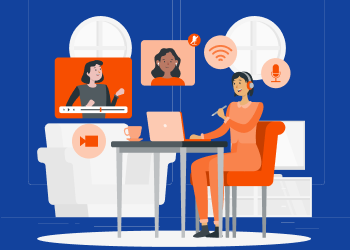Some of your clients will continue to work from their homes even after the pandemic eventually ends. Many businesses nowadays understand that they don't need office space, because operational efficiency is not reduced by the fact that most of the workforce is not in the office.
The key to working away from the office is secure and stable remote access solutions and a good educational process about these solutions. In this article, you will learn how to pitch to your clients about remote access and how to educate your end users about best practices and security essentials.
Pitching to Your Clients About Remote Access Solutions
Remote access is ”obviously” needed for any modern business. But what if you meet one customer to whom that’s not immediately so obvious? Here are the main points to convince them:
- Ability to work remotely.
- Secure connections. Your client might be aware of RDP connections and already have opened RDP to the Internet to allow their end users to connect to the office premises. This is a good time to let them know about the dangers of such an approach. A remote access tool should be configured and secured by a professional, so as to pre-empt a data breach.
Further reading Microsoft RDP Is Not Secure. Find Out How to Switch to MSP360 - Fast and easy support. Onsite support takes a lot of time, is expensive and, in most cases, is unnecessary. Let your clients know that they will reduce support costs significantly with remote access tools installed.
- The business won't be interrupted. Remember the panic of March-May 2020, when some businesses were not prepared for the sudden move from offices to homes? At that time, you probably helped dozens of clients to install a VPN and a remote access tool. However, some businesses suffered from downtime in operations, since the tools were not installed in time. So remote access should be available at all times, in order to prevent such downtime.
Educating Your Client About Working With Remote Access
Once you have provided your clients and end users with remote access, it's time to educate them about how to use it.
- Create documentation. Your documentation should cover each step of working with a remote access solution. Remember, your end users are not as tech-savvy as you are, so they need clear and simple explanations. Once the documentation is ready, test it on one of your friends or family members who doesn’t work in IT. This will show you if the documentation is clear enough.
- Documentation should be accessible. Great documentation is useless if your end users don’t know how to access it, or constantly forget about it. Email your learning materials to them and remind them once a month about the location of your knowledge base. This will reduce the number of support phone calls saying ”remote access is down”.
Further reading Guide to Creating MSP Documentation for Customers - Set up meetings or webinars. Lastly, on the basis of your documentation, create a presentation and host a webinar where you teach your end users yourself. Some people learn better during live sessions.
In the documentation and during your meetings, you should explain to your end users how they connect to the solution, where they should and can connect to, how they can perform basic troubleshooting, and how they can call you if they have issues.
List of Security Measures for Remote Access Usage
Here's a list of essential security measures you should include in your remote access proposition. We've also included best security practices your customers should know about when using remote access tools:
- MFA and password policy. Multi-factor authentication is an obvious must nowadays. Also, your end-user password policy should be strict, and passwords should be long and difficult.
Further reading Guide to MSP Password Management - VPN. Remote sessions that are open to the Internet are amongst the most popular security breach scenarios out there. Explain this to your customers and provide clear instructions on how to use the VPN.
- Sensitive-data usage. If your client's data falls under compliance, their end users should understand how sensitive data should be managed.
- Granting access. Remote access is a two-way tool. Your end user’s computer can both have access and grant it. Sometimes a hacker can try to connect to a user with privileged access rights, and so gather information for an upcoming hack. Hence, you should teach your clients how and why to protect themselves against unauthorized connection requests.
Further reading IAM vs PAM vs PIM: Guide to Access Management - How to ask for help. If your users have issues with any of your services, or their device was lost or locked during a ransomware attack, they should know how to contact you and what information they need to provide in order to solve the issue in the fastest way possible.
Education Is a Must
As we've already said, you should provide your clientele with setup and security awareness training sessions, even if you do it for free. And there are two good reasons for doing this. First of all, your clients will love the personal touch. And secondly, your clients' security is your reputation. And your reputation should be protected at all costs, since it's an essential component of your brand.





